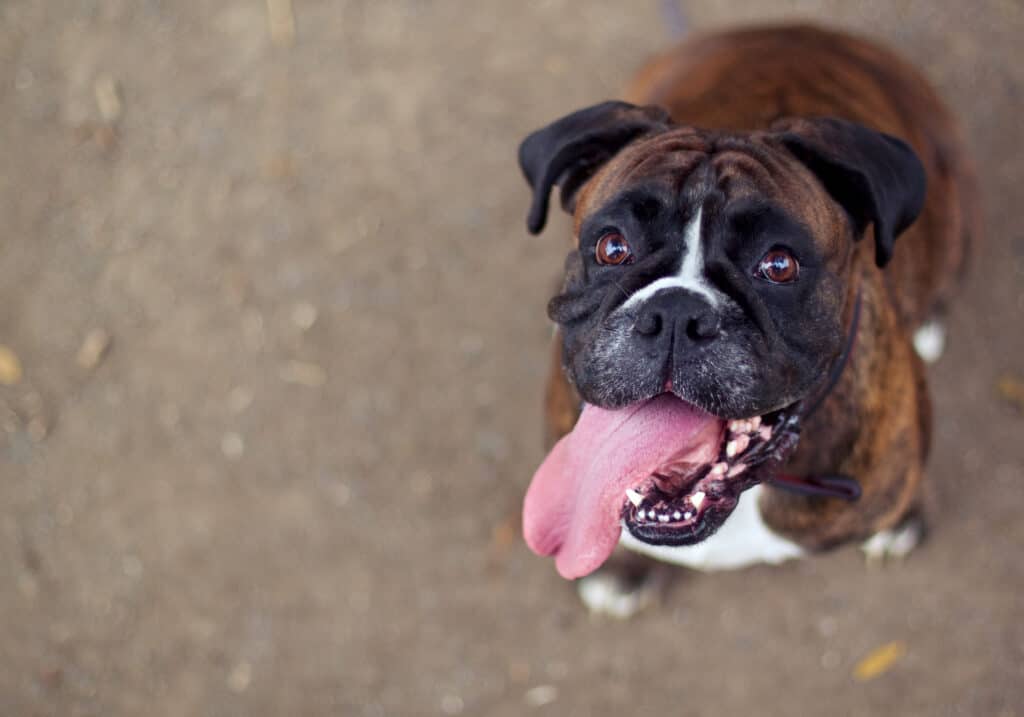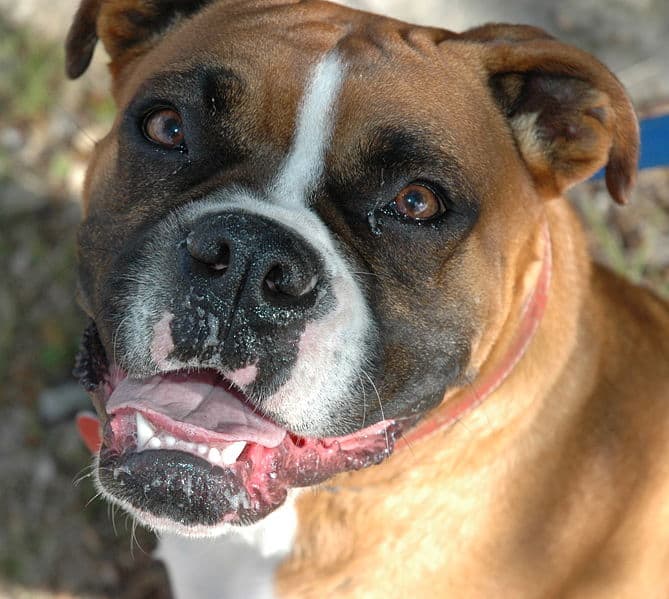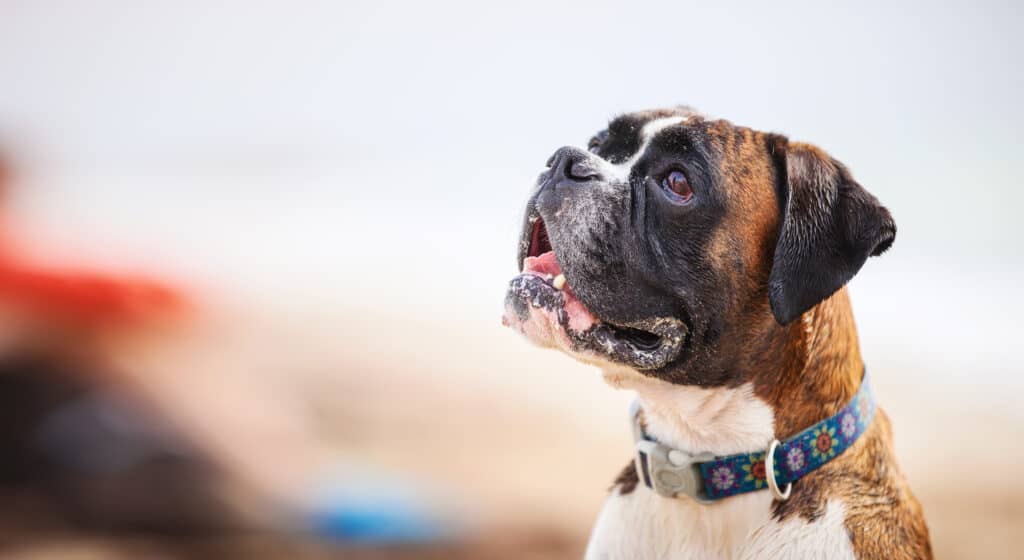The Boxer dog is one of the most unique dogs you’ll ever encounter. Are they Bulldogs? No. Are they rottweilers? Also no. The Old English Bulldog and another dog known as the Bullenbeisser were the ancestors of the modern Boxer. Don’t worry if you’ve never heard of the Bullenbeisser. You’re not alone. Since they went extinct due to crossbreeding, many haven’t heard of them.
Dog breeders started combining the two breeds to create the contemporary Boxer in the 1870s. The Boxer is arguably the most frequently used example when discussing “Peter Pan” canines. Boxers mature slowly; they can take up to three years to reach full maturity.
The origin of the name “Boxer” is unknown, and some assert that it originates from the moniker given to the Bullenbeisser. Others believe it stems from how they play, particularly how they jump up on people using their hind legs before “boxing” them with their front paws. No matter where they got their name, it certainly has nothing to do with their teeth. Below, we discuss everything you need to know about Boxer dog teeth.
What Kind of Teeth Do Boxer Dogs Have?

Boxer dogs have a complete set of heterodont teeth, including incisors, canines, premolars, and molars.
©Lyubov Timofeyeva/Shutterstock.com
Boxer dogs have a full set of heterodont teeth, including incisors, canines, premolars, and molars, just like all domesticated dog breeds. Like most mammals, Boxers only develop two sets of teeth. A deciduous set of teeth, often known as milk teeth, appear shortly after birth and are eventually replaced by permanent teeth as the Boxer ages.
As might be assumed, their canines are particularly pointed. Canids naturally have long, pointed canines that mimic fangs and are used to rend and cut through flesh. However, domesticated dogs today utilize their teeth more frequently on chew toys and other items, shredding hard chunks of meat in their food, and biting when necessary because they have evolved to eat soft or pre-sliced meals. Boxers occasionally bite or chew on their owners’ fingers. Their canines’ sharp edges can pierce flesh, especially while teething.
How Many Teeth Do Boxer Dogs Have?

Boxer dogs have 42 teeth.
©Vicki Mitchell from Austin, US, CC BY 2.0, via Wikimedia Commons – License
A Boxer has a total of 42 permanent adult teeth by the time it is fully grown, has gone through the teething stage, and is an adult dog.
During teething, 28 baby teeth break through a Boxer puppy’s gums. Most of the puppy’s milk teeth are present by the age of six weeks. There are 12 incisors (front teeth), with six on each side. The premolars, three on each side, top and bottom, are located next to the incisors.
Adult Boxers have a complete set of 42 teeth, with six incisors on the top and six on the bottom and four premolars on the top and bottom jaw. The adult Boxer dog’s molars also erupt behind the premolars – two molars on each side at the top and three on each side at the bottom.
Boxer Dog Teething
When the milk teeth fall out and are replaced by canines, teething begins. There can be early bloomers who start teething at four months or late bloomers who start at seven to eight months, but this phase often begins at five months of age. It is strongly advised to have a veterinarian perform a dental examination for any potential problems that might be keeping a puppy’s milk teeth from falling out by the time they are seven months old.
Teething would be one of the biggest challenges you and your dog will face throughout its lifetime, but luckily, this period will pass by quickly. Remember that your dog will experience discomfort and sometimes pain during this time, so they will try to chew on any object to relieve uncomfortable sensations. However, with some advanced preparation and simple training, you can prevent your puppy from wrecking your house and help your dog adjust.
What Do Boxer Dogs Use Their Teeth For?
Dogs use their teeth as weapons and tools for shredding or cutting food. The permanent teeth of the Boxer dog include incisors, which are utilized for biting and nipping. These tiny, flat-edged upper jaw incisors — the first two oddly pointed teeth — are used to scrape and gnaw food and other objects.
The canines follow, which rip and rend flesh. Two pairs of razor-sharp canines or fangs on both the upper and lower jaw are a shared feature of the huge group of canids. Furthermore, these teeth are razor-sharp enough to pierce the skin.
Lastly, there are the premolars and molars, which shear and smash. Boxers chew and shred food, wooden sticks, and toys with their premolars. Boxers utilize their molars, or grinding teeth, to break down their meal into tiny bits.
Common Dental Problems in Boxer Dogs

Poor dental care for Boxer dogs can lead to tooth abscess, making it difficult for them to chew.
©Photobac/Shutterstock.com
Boxer dogs might acquire a wide range of health issues if their owners don’t keep up with daily dental care practice. Toxin absorption into the dog’s bloodstream, bacterial infections, kidney issues, and joint injury are a few of these issues. Poor dental care for Boxer dogs can also lead to tooth abscess, making it difficult for them to chew. Bacterial endocarditis is a highly deadly condition in which bacteria from the mouth enter the animal’s heart.
Can Boxer Dogs Have an Underbite?
Boxers are renowned for having an eye-catching “smile” and underbite. When a dog’s teeth, whether baby or adult, don’t fit together properly, it is known as canine malocclusion or an underbite. Some breeds, including the Shih Tzu, Bulldog, and numerous Terrier breeds, are prone to this tooth condition.
For dogs, having an underbite isn’t always a bad thing. Some puppies are born with this dental condition, which poses no health risks, particularly if their teeth are in good condition. However, if your dog already has other dental concerns or needs oral surgery, an underbite might lead to some significant difficulties. This may interfere with your Boxer’s ability to eat, chew, and occasionally even breathe.
Up Next:
The Best Food for Boxers for 2022
Boxer Lifespan: How Long Do Boxers Live?
Sea Turtle Teeth: Everything You Need To Know
Rottweiler vs Boxer: Key Differences Explained
The photo featured at the top of this post is © EB Adventure Photography/Shutterstock.com
Ready to discover the top 10 cutest dog breeds in the entire world?
How about the fastest dogs, the largest dogs and those that are -- quite frankly -- just the kindest dogs on the planet? Each day, AZ Animals sends out lists just like this to our thousands of email subscribers. And the best part? It's FREE. Join today by entering your email below.
Sources
- AllBoxerInfo, Available here: http://www.allboxerinfo.com/boxer-dog-teeth-dental
- Daily Dog Drama, Available here: https://dailydogdrama.com/dog-care/boxer-with-underbite/
Thank you for reading! Have some feedback for us? Contact the AZ Animals editorial team.






